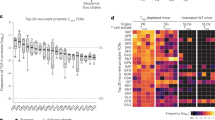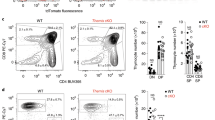Abstract
I–J has been defined as a locus mapped in the murine major histocompatibility complex (MHC) which encodes serological markers found primarily on the surface of suppressor T cells (Ts) and soluble suppressor factors (TsF)1,2. Recent studies have, however, revealed that there is no such specialized locus within the MHC at the DNA level3,4. As the existence of I–J determinants at the protein level on functional T cells, T-cell clones and hybridomas has been confirmed by several serological and biochemical studies5–7, this contradiction has raised serious arguments in the immunological community concerning the nature, origin and expression of I–J determinants. We have raised a number of monoclonal antibodies against the polymorphic structure of I–J molecules, and have studied the expression of I–J epitopes on T cells derived from irradiated bone marrow chimaeras in which stem cells of different genotype differentiated into T cells under the foreign host MHC environment. The results, presented here, indicate that I–J epitopes are not primarily determined by the MHC genes of the stem cells themselves, but are adaptively acquired by T cells differentiated in the chimaeric condition according to the environmental MHC phenotype. Thus, the serologically detectable I–J epitopes are found to be associated with inducible T-cell receptors recognizing self class II MHC antigens.
This is a preview of subscription content, access via your institution
Access options
Subscribe to this journal
Receive 51 print issues and online access
$199.00 per year
only $3.90 per issue
Buy this article
- Purchase on Springer Link
- Instant access to full article PDF
Prices may be subject to local taxes which are calculated during checkout
Similar content being viewed by others
References
Murphy, D. B., Herzenberg, L. A., Okumura, K., Herzenberg, L. A. & McDevitt, H. O. J. exp. Med. 144, 699–712 (1976).
Tada, T., Taniguchi, M. & David, C. S. J. exp. Med. 144, 713–725 (1976).
Steinmetz, M. et al. Nature 300, 35–42 (1982).
Kobori, J. A., Winoto, A., McNicholas, J. & Hood, L. J. molec. cell. Immun. 1, 125–131 (1983).
Niederhuber, J. E., Alien, P. & Mayo, L. J. Immun. 122, 1342–1349 (1979).
Habu, S., Yamauchi, K., Gershon, R. K. & Murphy, D. B. Immunogenetics 13, 215–225 (1981).
Yamauchi, K., Chiao, N., Murphy, D. B. & Gershon, R. K. J. exp. Med. 155, 655–665 (1981).
Uracz, W., Abe, R. & Tada, T. Proc. natn. Acad. Sci. U.S.A. 82, 2905–2909 (1985).
Hiramatsu, K., Ochi, A., Miyatani, S., Segawa, A. & Tada, T. Nature 296, 666–668 (1982).
Miyatani, S., Hiramatsu, K., Nakajima, P. B., Owen, F. L. & Tada, T. Proc. natn. Acad. Sci. U.S.A. 80, 6336–6340 (1983).
Kurata, A. et al. J. molec. cell. Immun. 1, 267–277 (1984).
Singer, A., Hathcock, K. S. & Hodes, R. J. J. exp. Med. 149, 1208–1226 (1979).
Wieder, K., Araneo, B. A., Kapp, J. A. & Webb, D. R. Proc. natn. Acad. Sci. U.S.A. 79, 3599–3603 (1982).
Ochi, A., Nonaka, M., Hayakawa, K., Okumura, K. & Tada, T. J. Immun. 129, 227–231 (1982).
Saito, T. & Taniguchi, M. J. molec. cell. Immun. 1, 137–145 (1984).
Kumagai, Y., Okumura, K. & Tada, T. Molec. Immun. 21, 545–559 (1984).
Ikezawa, I. et al. Proc. natn. Acad. Sci. U.S.A. 80, 6637–6641 (1983).
Schrader, J. Scand. J. Immun. 10, 387–393 (1979).
Hüning, T. & Bevan, M. J. exp. Med. 151, 1288–1290 (1980).
Sredni, B. & Schwartz, R. H. Immun. Rev. 54, 187–233 (1981).
Kaye, J. & Janeway, C. A. J. exp. Med. 159, 1397–1412 (1984).
Zinkernagel, R. M. & Doherty, P. C. Adv. Immun. 27, 51–177 (1979).
Hayes, C. E. et al. Science 223, 559–561 (1984).
Bevan, M. J. & Fink, P. J. Immun. Rev. 42, 3–19 (1978).
Sprent, J. Immun. Rev. 42, 108–137 (1978).
Longo, D. L., Matis, L. A. & Schwartz, R. H. CRC Crit. Rev. Immun. 2, 83–132 (1981).
Yamauchi, K., Flood, P. M., Singer, A. & Gershon, R. K. Eur. J. Immun. 13, 285–291 (1983).
Klyczek, K. K., Cantor, H. & Hayes, C. E. J. exp. Med. 159, 1604–1617 (1984).
Author information
Authors and Affiliations
Rights and permissions
About this article
Cite this article
Uracz, W., Asano, Y., Abe, R. et al. I–J epitopes are adaptively acquired by T cells differentiated in the chimaeric condition. Nature 316, 741–743 (1985). https://doi.org/10.1038/316741a0
Received:
Accepted:
Issue Date:
DOI: https://doi.org/10.1038/316741a0
This article is cited by
-
Antigen-specific suppressor factor: Missing pieces in the puzzle
Immunologic Research (1995)
-
The I-J-disparate mouse strains B10.A(3R) and B10.A(5R) have identical E? sequences
Immunogenetics (1990)
-
I-J-positive cloned macrophages as accessory cells for the induction of suppressor T cells in vitro
Immunologic Research (1986)
-
Cell-cell interaction responsible for the induction of first order suppressor T cells in hapten-specific contact sensitivity reactions
Immunologic Research (1986)
-
Cellular immunology: Suppressor T cells in the network
Nature (1985)
Comments
By submitting a comment you agree to abide by our Terms and Community Guidelines. If you find something abusive or that does not comply with our terms or guidelines please flag it as inappropriate.



